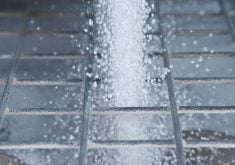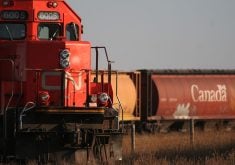When Gord Kozroski got his new bale cart, it brought with it a side benefit he never expected.
“It’s faster and more fun than anything. It follows you around like a dog. I can’t get Dad off that thing,” said Kozroski, describing his Haukaas accumulator.
The Gull Lake, Sask., grower runs a 500 head cow herd, putting up 2,200 to 3,500 big round bales per year.
His first exposure to the Haukaas Quick Pick accumulator bale carrier came in 2004 when Greg Haukaas hauled his prototype out to the Kozroski farm for testing. Kozroski was impressed and rented a unit for the next few years.
Read Also

Crop quality looks good this year across Prairies
Crop quality looks real good this year, with the exception of durum.
“But buying this thing two years ago is one of the best decisions I’ve made. I used to pay $300 a day and I was killing myself working three or four days straight from 7 a.m. until midnight to get the most out of it.
“I finally bought this two years ago and put up half the bales myself. Dad and the hired man put up the other half.
“In 2013, they wouldn’t even let me get on the machine. They had me driving semi the whole time, just trying to keep up. Dad’s 67. He really likes running this thing.”
The bale cart picks up 10 bales in two rows of five. There are are no drag chains or individual bale lifts. Instead, it slides the bales along a frame using the forward motion of the machine and tractor. Bales remain oriented in their original positions as they were on the field.
“It takes about half a day to figure out the patterns so you line up the bales in a good system.”
Kozroski uses the L-shaped bale lineup configuration, one of the methods Haukaaas recommends to make efficient use of the bale cart.
L-shape or parallel groups of 30 bales are the most efficient for loading a 53 foot bale trailer.
“The L-shape, that was my idea,” said the Gull Lake farmer.
Kozroski said the unit he first rented showed no sign of emergency repair or deterioration. He has enough confidence in the quality that he rents the bale cart out to other producers, which covers about half his payments.
For more information, contact Kozroski at 306-672-7463 .















